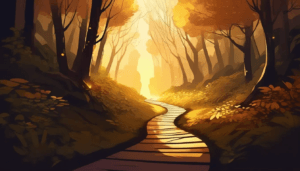In the fast-paced whirlwind of modern life, we often lose touch with who we are at our core. Beneath the surface of our daily routines lies a deeper self—rich, mysterious, and untapped. But how do we access that part of ourselves that often feels elusive? The work of renowned psychologist Carl Jung offers a map for this journey, guiding us through the hidden layers of our psyche, urging us to confront our shadows, and revealing the powerful symbols that shape our lives.
This is not just a theoretical map; it is a living, breathing process that invites you to explore and engage with the deepest parts of yourself. Jung’s ideas help you unlock the vast potential within, uncovering the wisdom of your unconscious mind and leading you toward a fuller, more authentic life. Let’s walk through this journey—one that takes you beyond your ego and into the very heart of your being.
Step 1: Listen to Your Dreams
Carl Jung once said, “The dream is the small hidden door in the deepest and most intimate sanctum of the soul.” Dreams, in Jung’s view, are messages from the unconscious, offering us symbols and narratives that often point to aspects of our inner world we may not yet be aware of. By paying close attention to your dreams, you begin the first step of your journey—tuning into the voice of your unconscious mind.
Dreams carry the language of symbols, and these symbols hold meanings that are unique to you. Start by keeping a dream journal. Write down what you remember, even if it’s only fragments. Over time, you will begin to notice patterns—recurring themes, people, or images that may reflect something deeper than your everyday thoughts. Ask yourself: What is my unconscious mind trying to tell me?
Step 2: Identify Your Archetypes
Once you’ve started to unlock the meaning of your dreams, you enter the realm of archetypes. These are universal symbols that appear in every culture—figures like the Hero, the Mother, the Wise Old Man, or the Shadow. According to Jung, these archetypes live within the collective unconscious, a shared psychological space that all humans are connected to.
Understanding which archetypes are playing out in your life can help you see yourself and your actions in a new light. Perhaps you are living out the role of the Hero, bravely confronting challenges. Or maybe the Shadow—the parts of yourself you would rather hide—keeps emerging in unexpected ways. These archetypes give structure to your journey, helping you recognize that you are part of a much larger human story.
Step 3: Face Your Shadow
Speaking of the Shadow, this is where the work gets personal. The Shadow represents the parts of ourselves that we deny or repress. It’s the anger we suppress, the envy we pretend not to feel, or the vulnerability we hide from others. But Jung believed that true growth comes from facing this darker side, not running from it.
Jung once said, “One does not become enlightened by imagining figures of light, but by making the darkness conscious.” When you confront your Shadow, you reclaim the energy you’ve spent avoiding uncomfortable emotions. You become more whole. Reflect on where your triggers lie, on the emotions that arise when you feel challenged. By acknowledging your Shadow, you take an essential step toward integrating all parts of yourself.
Step 4: Embrace Synchronicity
As you delve deeper into your inner world, you may begin to notice moments of synchronicity—what Jung called “meaningful coincidences.” These are events that seem to be random on the surface but carry a deeper meaning, as if the universe is speaking directly to you.
Perhaps you think about an old friend, and they suddenly call you out of the blue. Or you find the perfect book just when you need it most. Jung believed these moments are not random; they are signs that your inner world and outer world are aligned. They remind you that life is interconnected and that there is a deeper order beyond what we can see.
Pay attention to these moments. They are often clues from the universe guiding you on your path.
Step 5: Reconnect with Your Soul
Modern life can leave us feeling disconnected from our deeper selves, caught up in routines and external pressures. Jung wrote Modern Man in Search of a Soul to address this sense of spiritual disconnection. He believed that true fulfillment comes from reconnecting with our inner essence—what some might call the soul.
For Jung, reconnecting with the soul is not necessarily a religious practice, but rather a deeply personal one. It might involve meditation, spending time in nature, or engaging in creative work. These practices help you attune to the parts of yourself that are often drowned out by the noise of the world.
Ask yourself: What activities nourish my soul? Whether it’s journaling, painting, or sitting quietly by the water, make space for these moments in your life.
Step 6: Heal Your Childhood Wounds
Our adult selves are often shaped by childhood experiences, both positive and painful. Jung understood that many of the conflicts we face as adults are rooted in early wounds—things we may have long forgotten but still carry within us.
To truly grow, we must revisit these childhood conflicts with compassion and understanding. This might involve therapy or deep reflection, allowing ourselves to see how past events still influence our present lives. By healing these early wounds, we open ourselves to greater emotional freedom and peace.
Step 7: Use Relationships as Mirrors
As you journey deeper into self-discovery, you’ll notice that relationships often act as mirrors, reflecting back the parts of ourselves we may not fully see. Jung called this transference—when we project our own unconscious feelings onto others. Whether it’s love or frustration, the way we react to people often reveals something about our own inner world.
Use your relationships as opportunities for growth. When someone triggers a strong emotion in you, pause and reflect: What is this person showing me about myself? This insight can be a powerful tool for personal evolution.
Step 8: Tap Into Your Psychic Energy
Jung believed that our psychic energy drives us toward growth and creativity. This energy flows freely when we are aligned with our deeper purpose but can become blocked when we resist our inner truth. Notice when you feel stuck or uninspired—this is often a sign that your energy is being drained by unresolved emotions or unmet needs.
Engage in activities that inspire and energize you. By following your passions and paying attention to what lights you up, you align with the natural flow of your own psychic energy.
Step 9: Embrace Your Spiritual Journey
Jung’s work often bridged psychology and spirituality, recognizing that true self-discovery is as much a spiritual process as a psychological one. By engaging with practices that nourish your spirit, whether through meditation, creative expression, or quiet contemplation, you deepen your connection with the world around you and with the mysteries of existence itself.
Jung’s writings on spirituality remind us that the journey toward self-awareness is not separate from the spiritual quest—it is the same path. As you continue to grow, you will find that understanding yourself brings you closer to understanding the larger questions of life.
Step 10: Reflect on Your Life’s Journey
As you approach the final steps of your journey, pause to reflect on the road you’ve traveled. Carl Jung’s Memories, Dreams, and Reflections is an invitation to look back on the key moments of your own life and see how they have shaped the person you are today.
Your journey is ongoing, always evolving. Each step forward brings new insights, new challenges, and new opportunities to deepen your understanding of yourself. But by engaging with Jung’s ideas, you now have a map—a way to navigate the complexities of your inner world and unlock the full potential of who you are.
This is the journey Jung offers: a path to self-realization through dreams, symbols, synchronicity, and soul. It’s not always easy, but it’s deeply rewarding. Along the way, you will encounter your shadows, face your fears, and experience moments of profound insight. Most importantly, you will come to know yourself in ways that may have once seemed impossible.
And that, ultimately, is the most beautiful gift of all.



